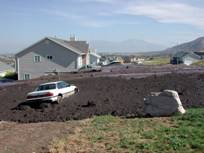Quantitative Risk Assessments
On this page
Debris Flow Impact Database
Under the Public Safety Geoscience Program, Natural Resources Canada (NRCan) has a commitment to provide information and knowledge to assist in analyzing the threats, vulnerabilities and risks posed by natural hazards, and in evaluating mitigation strategies that promote the safety and security of Canadians. The Quantitative Risk Assessments (QRA) project is responsible for the development of methods to estimate losses and to inform risk reduction strategies. One such tool utilizes the Debris Flow Impact Database.
The database is currently populated with 68 "seed" case studies that document the extent of damage to buildings by debris flow events, and in which intensity parameters (flow depth, flow velocity, peak discharge, and total volume) are known or can be inferred from direct observation. The "seed" data was derived from a review of global journals and conference proceedings. Information and knowledge contained in the database (e.g., intensity-damage relationships) provide a starting point for analyzing the extent of such damage in other regions.
NRCan has undertaken this work in order to generate new knowledge in this area. Principal objectives are to:
- Verify proposed damage models for existing building types.
- Establish intensity-damage relationships for additional building types and other critical assets (e.g., transportation and utility infrastructure).
- Increase the robustness of damage functions for hazard event intensities that are not well represented in the existing database (e.g., lesser magnitude events).
Outputs of this work will extend the scope and capabilities of Hazus (a standardized loss estimation methodology) to analyze the impacts and consequences of debris flow hazards, and to evaluate mitigation strategies (e.g., engineered mitigation measures and land use planning) that reduce the vulnerabilities of people and critical assets in areas exposed to debris flow hazards.
The database has been used to develop a building vulnerability model that uses an "intensity index". This model is documented in the "Vulnerability of buildings to debris flow impact" paper published in the Journal of the International Society for the Prevention and Mitigation of Natural Hazards.
Validation and refinement of damage models for debris flow hazards will require ongoing input and feedback from domain experts from around the world. The database can be downloaded for use in a Microsoft Excel format. The file contains information for potential contributors who wish to add their debris flow event data to the database for further collaboration. For more information, potential contributors are encouraged to contact the Activity Lead.
The Debris Flow Impacts Database contributes to broader goals and objectives of CHIS by establishing a capability to characterize the relative severity of debris flow in terms of expected physical impacts and/or consequences.
Contact information
Mailing Address
Natural Resources Canada
1500 – 605 Robson Street
Vancouver BC V6B 5J3
Canada
Phone, Fax and Email
- Phone:
- (604) 666-3955
- Fax:
- (604) 666-1124
- Email:
- nicky.hastings@canada.ca
